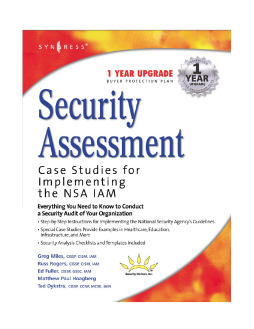
Additional Information
Book Details
Abstract
The National Security Agency's INFOSEC Assessment Methodology (IAM) provides guidelines for performing an analysis of how information is handled within an organization: looking at the systems that store, transfer, and process information. It also analyzes the impact to an organization if there is a loss of integrity, confidentiality, or availability. Security Assessment shows how to do a complete security assessment based on the NSA's guidelines.
Security Assessment also focuses on providing a detailed organizational information technology security assessment using case studies. The Methodology used for the assessment is based on the National Security Agency's (NSA) INFOSEC Assessment Methodology (IAM). Examples will be given dealing with issues related to military organizations, medical issues, critical infrastructure (power generation etc).
Security Assessment is intended to provide an educational and entertaining analysis of an organization, showing the steps of the assessment and the challenges faced during an assessment. It will also provide examples, sample templates, and sample deliverables that readers can take with them to help them be better prepared and make the methodology easier to implement.
- Everything You Need to Know to Conduct a Security Audit of Your Organization
- Step-by-Step Instructions for Implementing the National Security Agency's Guidelines
- Special Case Studies Provide Examples in Healthcare, Education, Infrastructure, and more
In 1998, the National Security Agency (NSA) Information Assurance Methodology (IAM) was developed to meet the demand for information security (INFOSEC) assessments-a demand that was increasing due to Presidential Decision Directive 63 (PDD-63) while at the same time NSA was downsizing. NSA sought a way to maximize its resources to assist as many customers as possible and so they created a list of organizations that could perform the same service as the NSA. NSA quickly realized that this system would not only provide valuable information to consumers-it would also provide a vehicle for standardization of INFOSEC assessments.
Define What Composes an Assessment
Learn about the NSA’s three-phases: Assessment,
Evaluation, and Red teaming
Understand Industry Concerns for the Assessment Site
Review the items that affect your client: Health Insurance Portability and Accounting Act of 1996 (HIPAA), Sarbanes-Oxley, Financial Management and Accountability (FMA) Act, Family Education Rights and Privacy Act (FERPA), and others.
Create the Organizational Information Criticality Matrix (OICM)
Create the OICM, which provides a basis for everything else in the methodology and clarifies the intentions and goals of the assessment process for the customer.
Handle Documentation Identification and Collection
Work with the client to gather and define documents such as policy, guidelines, plans, SOPs, user documentation and see what happens when no documentation exists.
Understand the Technical Assessment Plan (TAP)
Use the TAP to define all dates and scheduling, personnel involvement, understood boundaries, deliverables, priority concerns, and priority constraints.
Review the 18 NSA INFOSEC Baseline Classes and Categories
Use these 18 categories to address the customer’s security posture and determine what questions should be asked during the interview process.
Create a Recommendation Road Map
Provide the customer with a road map to the best way to address or implement the corrective measures for negative findings.
Understand the Findings
Assess the overall risk to a customer by looking at the threats, vulnerabilities, and asset value and analyze both negative and positive findings to create a true picture of the customer’s security posture.
Register for Your 1 Year Upgrade
The Syngress Solutions upgrade plan protects you from content obsolescence and provides monthly mailings, whitepapers, and more!
